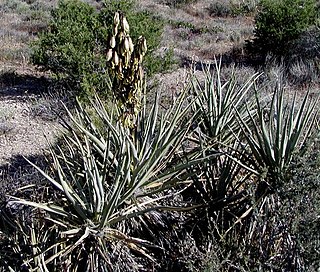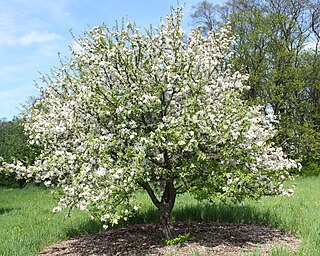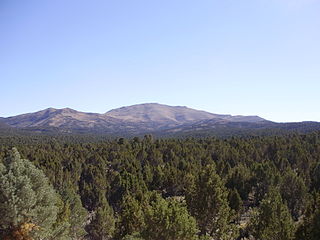
Yucca baccata is a common species of yucca native to the deserts of the southwestern United States and northwestern Mexico, from southeastern California north to Utah, east to western Texas and south to Sonora and Chihuahua. It is also reported in the wild in Colombia.

Abies concolor, the white fir, concolor fir, or Colorado fir, is a coniferous tree in the pine family Pinaceae. This tree is native to the mountains of western North America, including the Cascade Range and southern Rocky Mountains, and into the isolated mountain ranges of southern Arizona, New Mexico, and Northern Mexico. It naturally occurs at elevations between 900 and 3,400 metres.

The blue spruce, also commonly known as green spruce, Colorado spruce, or Colorado blue spruce, is a species of spruce tree. It is native to North America, and is found in USDA growing zones 1 through 7. It is found naturally in Arizona, Colorado, Idaho, New Mexico, Utah and Wyoming. It has been widely introduced elsewhere and is used as an ornamental tree in many places far beyond its native range. The blue spruce has blue-green colored needles and is a coniferous tree.

Yucca gloriosa is a species of flowering plant in the family Asparagaceae, native to the southeastern United States. Growing to 2.5 m (8 ft), it is an evergreen shrub. It is widely cultivated as an ornamental for its architectural qualities, and has reportedly become established in warmer climates in the wild in various parts of the world.

Yucca rostrata also called beaked yucca, is a tree-like plant belonging to the genus Yucca. The species is native to Texas, and the Chihuahua and Coahuila regions of Mexico. This species of Yucca occurs in areas that are arid with little annual rainfall.

Allium atrorubens is a species of wild onion known by the common name dark red onion. This plant is native to the southwestern United States where it grows in the sandy soils of the Mojave Desert, the Great Basin and higher-elevation deserts in Nevada, eastern California southwestern Utah, northwestern Arizona.

Malus prunifolia is a species of crabapple tree known by the common names plumleaf crab apple, plum-leaved apple, pear-leaf crabapple, Chinese apple and Chinese crabapple. It is native to China, and is grown elsewhere for use as an ornamental tree or as rootstock. It reaches from between 3 and 8 meters tall and bears white flowers and yellow or red fruit.

Celtis reticulata, with common names including netleaf hackberry, western hackberry, Douglas hackberry, netleaf sugar hackberry, palo blanco, and acibuche, is a small- to medium-sized deciduous tree native to western North America.

Pinyon–juniper woodland, also spelled piñon–juniper woodland, is a biome found mid-elevations in arid regions of the Western United States, characterized by being an open forest dominated by low, bushy, evergreen junipers, pinyon pines, and their associates. At lower elevations, junipers often predominate and trees are spaced widely, bordering on and mingling with grassland or shrubland, but as elevation increases, pinyon pines become common and trees grow closer, forming denser canopies. Historically, pinyon-juniper woodland has provided a vital source of fuel and food for peoples of the American Southwest.

Yucca × schottii is a plant species in the genus Yucca, native to southern Arizona, southwestern New Mexico, and the northern parts of Sonora and Chihuahua. The common names are Schott's yucca, hoary yucca, and mountain yucca. The "×" in the name indicates that this is a nothospecies, regarded as being a natural hybrid between two other species. In this case, Yucca × schottii is believed to have originated as a hybrid between Y. baccata and Y. madrensis. Yucca × schottii is firmly established and does reproduce freely in the wild.

Symphyotrichum falcatum is a species of flowering plant in the family Asteraceae. Commonly called white prairie aster and western heath aster, it is native to a widespread area of central and western North America.

Yucca baileyi is a plant in the family Agavaceae. It is native to Utah, Arizona, New Mexico and Colorado but has been cultivated elsewhere. Much of its native range is within the boundaries of the Navajo (Diné) Reservation, hence the common name "Navajo yucca." The Navajo people make extensive use of yucca fibers to make a wide assortment of useful and ceremonial items. They also use the roots as soap. It is not considered to be threatened, as it has a large range and an overall stable population.

Yucca harrimaniaeTrel., the Spanish bayonet, is a species in the family Asparagaceae, native to Utah, Nevada, Colorado, northeastern Arizona and northern New Mexico, at elevations from 1000 m to 2700 m.

Yucca utahensis is a species in the family Asparagaceae, native to Utah, Nevada and Arizona. McKelvey

Portulaca suffrutescens, the shrubby purslane, is a plant species native to the southwestern United States and northern and central Mexico. It has been found in Arizona, New Mexico, Texas, Sonora, Chihuahua, Sinaloa, Durango, Querétaro and Guerrero.
Thelypodium laxiflorum, the droopflower thelypody, is a plant species native to the southwestern United States. It grows in open, rocky places on slopes and cliff faces, usually in pinyon-juniper woodlands at elevations of 4,900–10,200 feet (1,500–3,100 m). It has been reported from Utah, western Colorado, southern Nevada, northwestern Arizona, and northwestern New Mexico.

Allium macropetalum, the desert onion, is a species of wild onion native to the desert regions of southwestern United States and northwestern Mexico. It is known from desert plains and hills in Sonora, Arizona, Utah, Colorado, New Mexico, and Texas, at elevations up to 2500 m.

Najas gracillima, the slender waternymph, is a submerged species of aquatic plant in the Hydrocharitaceae family. found in lakes and streams. It is native to China, Russian Far East, Japan, Korea, Taiwan, Iran, Alberta, Ontario, Newfoundland, Nova Scotia, New Brunswick, the eastern United States. It is also considered introduced and naturalized in France, Spain, Italy and California.

Machaeranthera asteroides, the fall tansyaster, is a North American species of plants in the sunflower family. It is native to the southwestern United States and northern Mexico.
Heterotheca fulcrata, known by the common name rockyscree false goldenaster, is a North American species of flowering plant in the family Asteraceae. It has been found in northern Mexico and in the western United States.



















